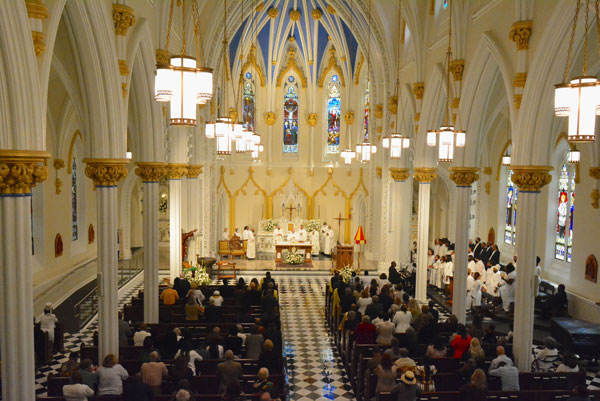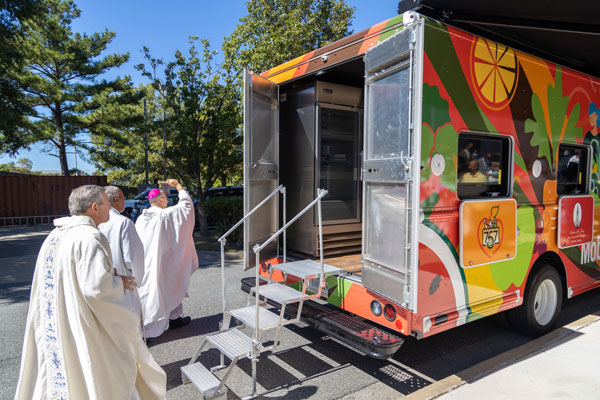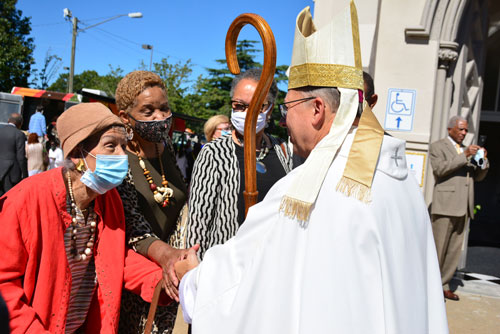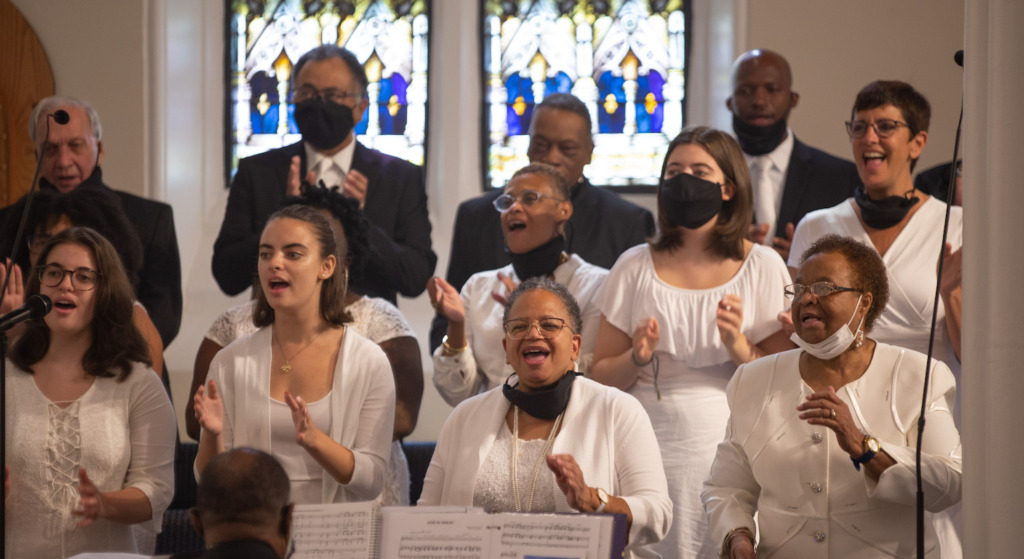As church renovations go, those at the Basilica of St. Mary of the Immaculate Conception in Norfolk had a modest start. While walking into Mass one Sunday in 2014, parishioner Will McCadden noticed a dip in the roof line. A physical inspection of the roof revealed it was leaking and that termites had eaten 60-70% of it. Damage was so extensive that had there been a strong storm, the roof would have “caved in,” he said.
During the planning stages to repair the roof, a plaster angel fell from an interior column to the area below where the youth choir was singing during a weekend Mass. No one was hurt, but it was a catalyst to investigate other hazards in the church interior.
As work progressed on the interior and exterior of the building, new issues were discovered.
“We kept finding things, and we kept finding things,” said McCadden, who served as project manager and whose company, Capitol General Construction, managed the project.

In addition to remedying safety issues, the parish also decided to make cosmetic changes when construction began in 2016.
About 75% of structural roof and upper columns were reconstructed. New pews with kneelers were installed and arranged to have a central aisle, something the church hadn’t had since a 1989 renovation.
Other renovations included a new floor, restoration of stained glass windows, installation of air conditioning and heating in the balcony, repairs to an existing restroom, turning the grand altar to face the congregation and plastering and painting. A platform for the choir was installed, the organ repaired and the angel replaced.
Other tasks completed during the project were restoration of existing lights and updating the sanctuary’s lighting to energy-efficient LED and installing a light dimming system and a fire/smoke detection system to assist in protecting the historic building.
‘Angels of glad tidings’
On Sunday, Sept. 26, Bishop Barry C. Knestout celebrated the Mass at which he dedicated the church and the altar of the basilica, the culmination of a project during which parishioners had to celebrate Mass in the fellowship hall for four and a half years. They were able to move back into the church on Dec. 8, 2020.
Quoting the Angel Gabriel’s words to the Blessed Mother at the Annunciation, “For nothing will be impossible for God” (Lk 1:37), Father Jim Curran, rector of the basilica, told the nearly 400 people gathered for the celebration that those words were fitting for what the parish had encountered and accomplished.
“We began this project as a simple roof repair and every week we discovered something new that needed to be replaced or repaired, including the revealing of a mysterious tunnel underneath the church and the crypts of former parishioners, long forgotten,” he said. “In the end the simple roof repair turned into a $6.7 million renovation and restoration. Impossible for us, but nothing will be impossible for God.”

Father Curran acknowledged “the kind and generous support of so many people, the angels of glad tidings that kept reminding us that nothing is impossible for God,” adding, “Every time we began to feel dejected and defeated someone was sent to announce it to us.”
In his homily, Bishop Knestout spoke on the importance of serving others, “no matter who they are, whether they are of our number or not.”
He continued, “This generosity of service to the poor and vulnerable is an honored legacy of this parish community.”
Each week, a soup kitchen serves hot meals to 800 to 1,000 people, and a food pantry gives groceries to 300 to 400.. Following the Mass, Bishop Knestout dedicated a new mobile food pantry which, starting in October, will take groceries to people in neighborhoods where there are no grocery stores.
Dr. Ruth Nichols, president and CEO of the Food Bank of Southeastern Virginia and the Eastern Shore provided the parish with a mobile market — a 20-foot truck that, according to Father Curran, “We can pack with fresh produce and fresh meats and dairy and bring it to the food deserts outside of our reach.”
History
Established in 1791, the basilica is the oldest Catholic community in the diocese and is often called “The Mother Church of Tidewater.” Located in downtown Norfolk, the parish was first called St. Patrick Church. It predates the establishment of the Richmond Diocese by 29 years. Early parishioners at St. Patrick were French Catholics fleeing persecution in the French Revolution. Later, some of the earliest Irish immigrants coming to the country joined the parish.
The original church, built in 1842, was destroyed by a fire in 1856, a suspected arson by the Know Nothings, a short-lived, once-secret political party in the mid-1800s known for its anti-immigrant and anti-Catholic beliefs.
The current church was built in 1858, and the parish changed its name to St. Mary of the Immaculate Conception, making it the first church so named after Pope Pius IX proclaimed the dogma of the Immaculate Conception on Dec. 8, 1854.
Black Catholics began worshipping there in 1886 in a portion of the choir loft reserved for them. Many African Americans left St. Mary when St. Joseph Parish was established for Black Catholics in Norfolk in 1889. St. Joseph Parish lost its church building due to urban development in 1961 and merged with St. Mary Parish.
On Dec. 8, 1991, the Church of St. Mary of the Immaculate Conception became a minor basilica. It is one of 34 minor basilicas in the United States, one of two in Virginia, and the only predominantly African American one in the country.
‘It’s about the warmth’
Parishioner Jimmy Gray said he was attracted to the parish 30 years ago because of the large number of Black Catholics worshipping together, the Gospel choir and music, the culture and the “whole African American experience,” which Dixon described as “spirit-filled, joyous, uplifting and very engaging.”
Cunningham said that listening to the Gospel choir “takes you to another level, to a spiritual place where you almost feel like you are the only one in that space and it’s literally just you and Jesus.”
Dana Dixon said the church is a Black Catholic legacy which needs to be “intact” and kept “beautiful and vibrant” for future generations.
The newly restored sanctuary is “absolutely breathtaking” and “stunningly beautiful,” according to parishioner Patty Costis
For Dana Gray, the worship space is breathtaking, magnificent, beautiful and awesome.
And for Monique Cunningham, it’s like a long- awaited “Christmas present.” After six years of construction and repairs, she finally got to metaphorically “rip the paper off,” adding, “It feels really good.”
Parishioners brought memories with them to the dedication.
Cerice White, 41, has been a parishioner all of her life and remembers that at one time, there was a Liturgy Alive ministry in which people would act out the readings during Mass. As a child, it kept her “engaged” and helped her “understand the Word a little bit better.”
Dixon said when she was a student at the now closed parish school, each spring there was a musical in which all of the students were required to participate. One year, the children in her fifth-grade class were recovering from chicken pox and performed with scabs and scars from the illness.
Karen Womack, 73, was a parishioner at St. Joseph as a child and then at the merged parishes. She remembers that there were different types of youth activities during the summer, such as cooking lessons, plays and baseball teams. When youth couldn’t get to an event or activity, one pastor would often take them.
She laments times past when there were daily rosary services, and the church was open during the day for private prayer. It was a place to go for refuge at any time. It provided an opportunity to draw strength, she said.
Parishioners praised the church for its warmth, sense of community and inclusiveness.
Ebyn Brinkley said, “The church itself is beautiful, but it’s about the warmth you get when you go in the doors and about feeling the presence of God when you are there.”

Nenneh Marshall, who is from Gambia in West Africa, has been a parishioner since the 1980s and described the parish as her “home away from home” where she feels “very welcome” and “part of the whole community.” She said Masses are “spiritually uplifting” and the parishioners “welcoming.”
Even children recognize the sense of community. Alivia White, 10, said she likes the church because it feels like a family where people love and care about her. Likewise, Noah Cunningham, 10, said he has a “church family” that he has come to know and love. When public Masses were suspended due to COVID, he planned to go back so he could socialize with them again.
Monique Cunningham said the beauty of the church is more than cosmetic.
“The building is beautiful, but there’s something about St. Mary’s that just grabs you even before the renovation occurred,” she said. “It’s rare that anyone leaves without feeling some sense of being full, being refueled to face whatever your oncoming week will play.”
Womack was moved by the rededication.
“It was a victory in Christ that we worshipped together as one in the basilica,” she said.
Dixon said, “The beauty of the church does enhance the experience, but it doesn’t change the amount of reverence that you bring to the space.”

